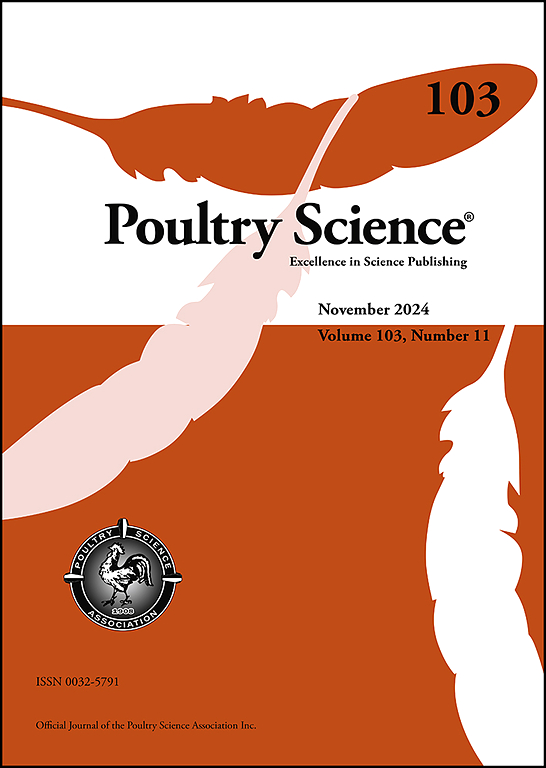辣椒纳米硒对肉鸡生长效率、血液生化、免疫反应、肠道形态和盈利能力的影响
IF 4.2
1区 农林科学
Q1 AGRICULTURE, DAIRY & ANIMAL SCIENCE
引用次数: 0
摘要
本研究评价了生物合成纳米硒(SeNPs)对肉鸡生产性能、生化参数、肠道形态、硒组织沉积、免疫反应和经济效益的影响。以辣椒提取物为原料合成了绿色SeNPs,并通过XRD、UV-Vis和FTIR光谱对其进行了表征。试验选取400只罗斯308肉鸡,分为5个饲粮组:对照组、0.3 ppm无机硒(T1)组和0.3、0.4和0.5 ppm有机硒(T2-T4)组。35 d时,记录生长性能、饲料转化率、血液和组织参数。虽然采食量、增重和FCR没有受到显著影响(P<0.05),但T4组的鸟类在数量上表现出优越的生长。高水平的有机SeNPs (T3、T4)显著(P<0.05)降低ALT、AST和尿素水平,提示肝肾功能改善。硒补充组的绒毛高度增加,隐窝深度减少,尤其是T4组,表明肠道健康得到改善。肝脏和血液中硒积累量显著增高(P<0.05),尤其是T1和T4。体液免疫无显著影响(p < 0.05)。经济上,尽管饲料成本略有增加,但有机SeNPs提高了盈利能力,T4的回报最高。这些发现支持使用生物合成SeNPs,特别是0.5 ppm的SeNPs,作为提高肉鸡健康和生产力的成本效益策略。本文章由计算机程序翻译,如有差异,请以英文原文为准。
Eco-friendly selenium nanoparticles from Capsicum annuum: Impact on growth efficiency, blood biochemistry, immune response, intestinal morphology, and profitability in broiler chickens
This study evaluated the effects of biosynthesized selenium nanoparticles (SeNPs) on performance, biochemical parameters, intestinal morphology, selenium tissue deposition, immune response, and economic return in broilers. Green SeNPs were synthesized using Capsicum annuum extract and characterized via XRD, UV–Vis, and FTIR spectroscopy. A total of 400 Ross 308 broiler chicks were allocated into five dietary groups: control, 0.3 ppm inorganic selenium (T1), and 0.3, 0.4, and 0.5 ppm organic SeNPs (T2–T4). Over 35 days, growth performance, feed conversion, and blood and tissue parameters were recorded. Although feed intake, weight gain, and FCR were not significantly affected (P<0.05), birds in T4 showed numerically superior growth. Higher levels of organic SeNPs (T3, T4) significantly (P<0.05)) reduced ALT, AST, and urea levels, indicating improved hepatic and renal function. Villus height increased, and crypt depth decreased in Se-supplemented groups, particularly in T4, suggesting enhanced intestinal health. Selenium accumulation was significantly (P<0.05) higher in liver and blood, especially in T1 and T4. Humoral immunity was not significantly (P<0.05) influenced. Economically, despite slightly increased feed costs, organic SeNPs improved profitability, with T4 yielding the highest return. These findings support the use of biosynthesized SeNPs, especially at 0.5 ppm, as a cost-effective strategy to enhance broiler health and productivity.
求助全文
通过发布文献求助,成功后即可免费获取论文全文。
去求助
来源期刊

Poultry Science
农林科学-奶制品与动物科学
CiteScore
7.60
自引率
15.90%
发文量
0
审稿时长
94 days
期刊介绍:
First self-published in 1921, Poultry Science is an internationally renowned monthly journal, known as the authoritative source for a broad range of poultry information and high-caliber research. The journal plays a pivotal role in the dissemination of preeminent poultry-related knowledge across all disciplines. As of January 2020, Poultry Science will become an Open Access journal with no subscription charges, meaning authors who publish here can make their research immediately, permanently, and freely accessible worldwide while retaining copyright to their work. Papers submitted for publication after October 1, 2019 will be published as Open Access papers.
An international journal, Poultry Science publishes original papers, research notes, symposium papers, and reviews of basic science as applied to poultry. This authoritative source of poultry information is consistently ranked by ISI Impact Factor as one of the top 10 agriculture, dairy and animal science journals to deliver high-caliber research. Currently it is the highest-ranked (by Impact Factor and Eigenfactor) journal dedicated to publishing poultry research. Subject areas include breeding, genetics, education, production, management, environment, health, behavior, welfare, immunology, molecular biology, metabolism, nutrition, physiology, reproduction, processing, and products.
 求助内容:
求助内容: 应助结果提醒方式:
应助结果提醒方式:


